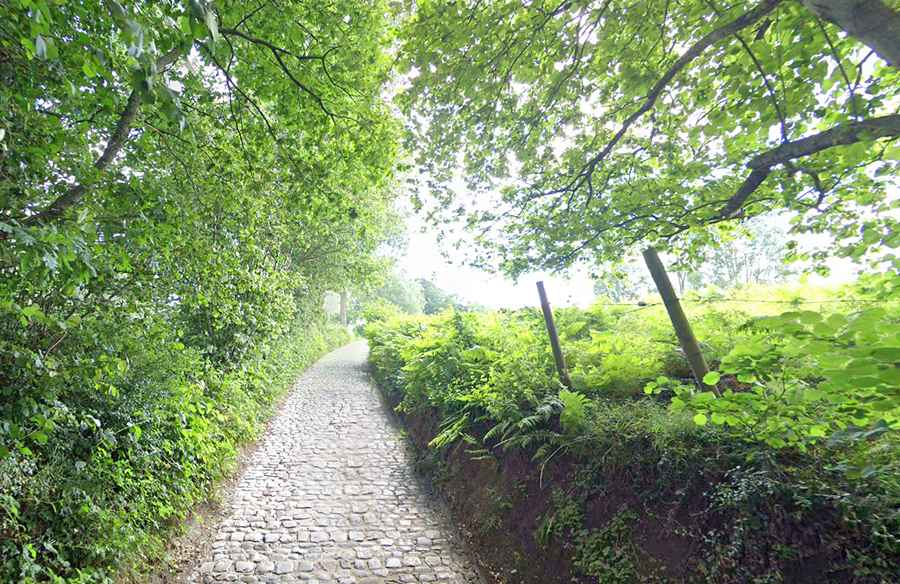Koppenberg: Just Over 600 Meters of Pure Hell for Cyclists
It’s just over 600 meters, but they contain all the toughness that haunts the nightmares of professional cyclists: 20% gradients and slippery cobblestones, which often force even the most renowned pros to dismount—just like Eddy Merckx did back in the day. Welcome to Koppenberg, the impossible climb of the Tour of Flanders. This hill, located on the outskirts of the city of Melden in the Belgian Ardennes, is the crown jewel of the Tour of Flanders. Though modest in elevation, it plays a disproportionately large role in shaping the outcome of the race.

A Brutal Race with Deep Roots
The race, known as De Ronde van Vlaanderen in Flemish, has been held since 1913 and didn’t even stop during World War II.
Like many cycling races, it was born out of the need to promote a sports newspaper called Sportwereld. For the Flemish, the race is part of their identity and one of their greatest sources of pride.
Over the years, the Tour of Flanders has evolved into a high-stakes tactical battle. The course regularly features short, sharp climbs—known locally as hellingen—many of them cobbled. Among them, none is as feared or legendary as Koppenberg.
The Numbers Are Frightening
The stats are daunting, but they don’t quite capture how hard it is to conquer Koppenberg. An average gradient of 11.1%, 600 meters in length, and a climb to just 76 meters above sea level, with maximum gradients reaching 20%.
"The Steepest Hill in the World"
The cobblestones make everything much more difficult: even though the race organizers maintain them, they always appear greasy, damp, and slippery, even on sunny days.
Legend has it that a former rider, Walter Godefroot—a Belgian and two-time Tour of Flanders winner in 1968 and 1978—was the one who suggested including the climb.
The organization included it for the first time in 1976. And it was precisely that year when it delivered one of the most unusual scenes in cycling history: Eddy Merckx dismounting on the climb.
(Just last year, most of the peloton had to get off their bikes. Only a chosen few managed to ride up, among them Mathieu van der Poel, brilliant winner in 2024 and top favorite for 2025.)
A Hill That Became a Legend
Little by little, Koppenberg built a legendary reputation. It came to be known as "the steepest hill in the world"—not for its height, of course, as it doesn’t exceed 78 meters, but for its difficulty. There aren’t many curves, but the road is narrow and full of traps.
Koppenberg is also referred to as "the hill of skulls," due to the size of its cobblestones—large and round like skulls buried in the mud—a macabre description that sums up the brutal challenges riders face on the climb.
There were editions of the Tour of Flanders that turned into a real nightmare because of Koppenberg, like in 1985, when only 24 riders managed to finish the race. Eric Vanderaerden won that year on a hellish day of cold, rain, and mud.
Why Do Riders Dismount?
But how is it possible that well-trained cyclists have to dismount on a hill? First of all, because it’s a narrow road. Everyone wants to be at the front: the leaders usually make it up without too much trouble, but those in the middle or back of the pack are exposed—if one rider dismounts, it practically forces the rider behind to do the same.
It’s a short climb, which leads many to not overcomplicate things: once they’re on foot, they just walk or try to run up.
Still, it's said that Koppenberg, which this year is located 44 km from the finish line, has caused more dropouts than the big mountain passes of the Tour de France.
The Climb Was Once Removed
However, the Tour of Flanders decided to drop Koppenberg in 1988. The carnage of 1985 and the incident in 1987—when Danish rider Jesper Skibby lost his chance to win on Koppenberg—led organizers to shelve the race’s most infamous climb.
The Skibby incident was dramatic: he was leading, with a ten-second advantage, but lost strength on Koppenberg and drifted to the right side of the road. The race director’s car ran over his bike, dragging it a few meters to the jeers (and a few laughs) of the crowd.
Skibby was unharmed, but his hopes of winning the Tour of Flanders were over.
Due to public criticism, Koppenberg was excluded from the race until 2002, when—after restoration—the climb returned.
The road had been improved and widened. The renovation cost €150,000, funded by the Oudenaarde region, where the finish line is located.
Even then, the debate wasn’t over: in 2006, only nine riders managed to climb it without dismounting. The race director, Wim van Herreweghe, faced a storm of criticism. The cobblestones had deteriorated again. “There’s too much space between the stones, and if it rains, it would be a disaster,” he said when he announced that Koppenberg would once again be left out of the 2007 race.
But Koppenberg Is Here to Stay
Fortunately for fans—and unfortunately for the riders—Koppenberg returned in 2008, and this time, it’s here to stay.